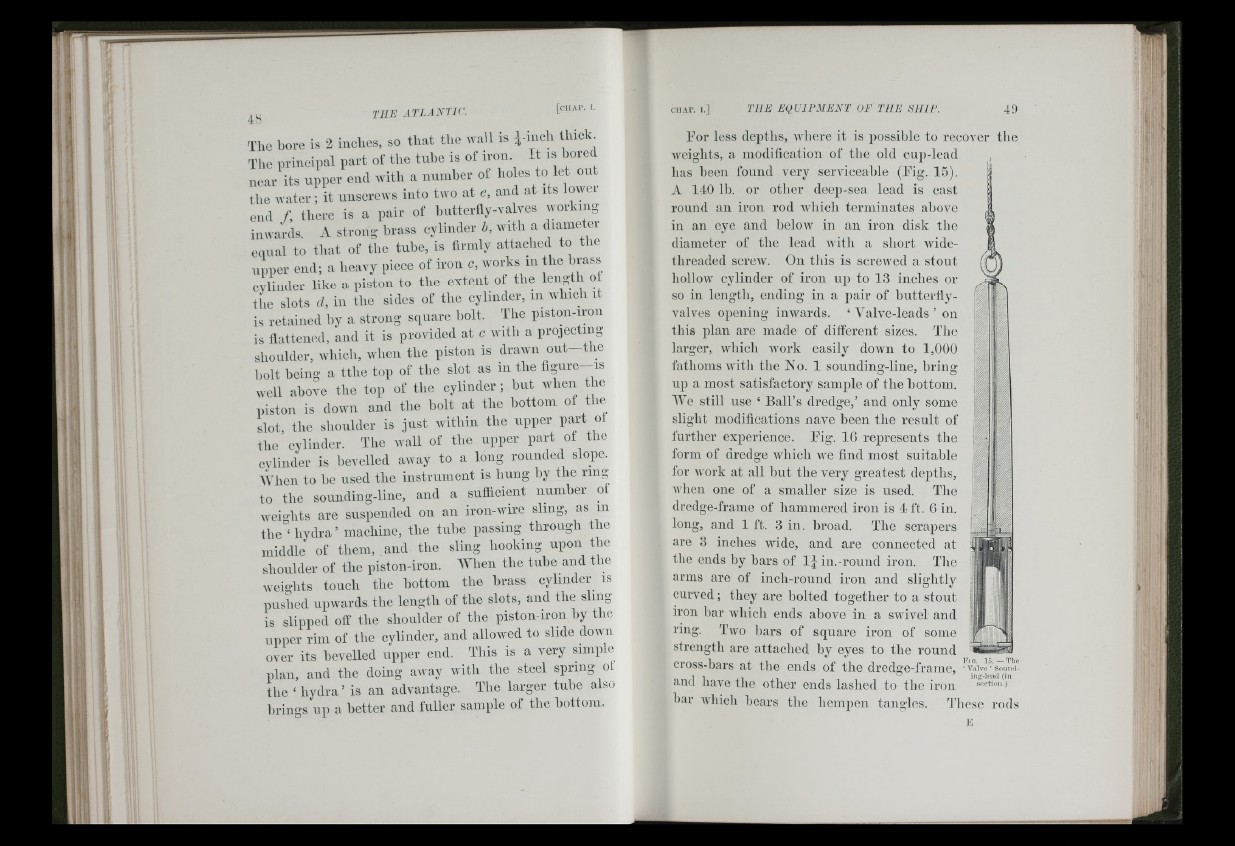
4S THE ATLANTI C. [ c h a p . I. CHAP. 1.] THE EQUIPMENT OP THE SHIP. 40
The bore is 2 inches, so that the wall is i-mch hick
Tbe principal part of the tuhe is of ivon. It is hoiec
near its upper end with a number of holes to let
the water; it unscrews into two at and at its lowei
end /; there is a pair of hutterfly-valves working
inwards. A strong brass cylinder h, with a diameter
equal to that of the tuhe, is firmly attached to the
upper end; a heavy piece of iron c, works in the brass
cylinder like a piston to the extent of the length o
the slots d, in the sides of the cylinder, in which it
is retained by a strong square holt. The piston-iron
is flattened, and it is provided at c with a projecting
shoulder, which, when the piston is drawn o n t - th e
holt heing a tthe top of tbe slot as in the fi§^ r e -is
well above the top of the cylinder ; hut when the
jiiston is down and the bolt at the hottom of the
slot, the shoulder is just within the upper part ot
the cylinder. The wall of the upper part of the
cylinder is bevelled away to a long rounded slope.
AYhen to he used the instrument is hung hy the ring
to the sonnding-line, and a sufficient number ot
weio-hts are suspended on an iron-wire sling, as in
the” hydra ’ machine, the tuhe passing through the
middle of them, and the sling hooking upon the
shoulder of the piston-iron. When the tube and the
weights touch the hottom the brass cylmder^ is
pushed upwards the length of the slots, and the sling
is slipped off the shoulder of the piston-iron hy the
upper rim of tbe cylinder, and allowed to slide doAvn
over its bevelled upper end. Tbis is a very simpm
plan, and the doing away with the steel spring of
the ‘ hydra ’ is an advantage. The larger tube also
brings np a better and fuller sample of the hottom.
Tor less depths, Avbere it is possible to recover tbe
Aveigbts, a modification of tbe old cup-lead
lias been found very serviceable (Tig. 15).
A 140 lb. or otber deep-sea lead is cast
round an iron rod AA’liich terminates above
in an eye and below in an iron disk tlie
diameter of tbe lead witli a sbort Avide-
tbreaded screw. On tbis is screwed a stout
bollow cylinder of iron up to 13 incbes or
so in length, ending in a pair of butterily-
valves opening inwards. ‘ Valve-leads ’ on
tbis plan are made of different sizes. Tbe
larger, wbicb VA’ork easily down to 1,000
fatboms Avitli tbe No. 1 sounding-line, bring
up a most satisfactory sample of tbe bottom.
We still use ‘ Ball’s dredge,’ and only some
sligbt modifications nave been tbe result of
furtber experience. Big. 16 represents tbe
form of dredge Avbicb Ave find most suitable
for Avork at all but tbe very greatest depths,
Avhen one of a smaller size is used. Tbe
dredge-frame of hammered iron is 4 ft. 6 in.
long, and 1 ft. 3 in. broad. The scrapers
are 3 incbes wdde, and are connected at
tbe ends by bars of l^in.-round iron. Tlie
arms are of inch-round iron and slightly
curved; they are bolted together to a stout
iron bar Avbicb ends above in a swuvel and
ring. Two liars of square iron of some
strength are attached by eyes to tbe round
cross-bars at the ends of tbe dredge-frame,
and have the otber ends lashed to the iron
bar Avbicb bears the hempen tangles. 3'besc rods
F i g . 1 5 .— The
‘ Valve ’ Sounding
lead (in
section.)
b
i: :
|:
M !
■4:
I"
■It
M l .
■Y
tl:'